Special Report
The Best and Worst Economies in the World

Published:
Last Updated:

The global economy’s growth of 2.5% in 2015 was down considerably from the 4.4% growth in 2010. Economic expansion is determined by two components: population growth and labor productivity. An aging population may partially explain the slower worldwide economic growth, but it is the sluggish productivity growth across the globe that is largely to blame.
In its 2016 Global Competitiveness Report, the WEF ranked the productivity — or competitiveness — of 138 national economies around the globe. The international organization examined government regulations, legal institutions, market size, health outcomes, educational attainment, and a range of other factors. To identify the most competitive economies, 24/7 Wall St. reviewed data compiled in the report.
Economies around the world exist at varying stages of development, and benefit from different drivers of competition at each stage. Countries in the earlier stages of development are called factor-driven economies and are characterized by low GDP per capita and heavy reliance on extractive industries such as oil, gas, and mining. For factor-driven economies, basic requirements — such as infrastructure and the health and primary education of residents — factor more heavily into competitiveness than in more developed countries. Of the 10 least competitive countries, nine are factor-driven economies.
Click here to see the best economies in the world.
Click here to see the worst economies in the world.
In innovation-driven economies, businesses usually have access to the most talented labor pools, developed financial markets, and the most advanced technology. In such economies, which are also characterized by high GDP per capita, companies must compete by increasing the sophistication of their business procedures. Therefore, innovation and sophistication factors — such as marketing tools and spending on research and development — factor more heavily into their competitiveness. All 10 of the most competitive countries are considered innovation-driven economies.
To identify the most and least competitive nations in the world, 24/7 Wall St. reviewed The Global Competitiveness Report 2016-2017 from the WEF. The report uses an index consisting of 114 indicators organized into 12 pillars assessing the productivity, or competitiveness, of 138 countries. All GDP figures, including debt as a percentage of GDP, were provided to the WEF by the International Monetary Fund. Population figures also came from the IMF, and the number of patent applications came from the Organization for Economic Co-operation and Development. All data, unless otherwise specified, are from the most recent year available.
These are the most (and least) competitive countries in the world.
The Most Competitive Economies
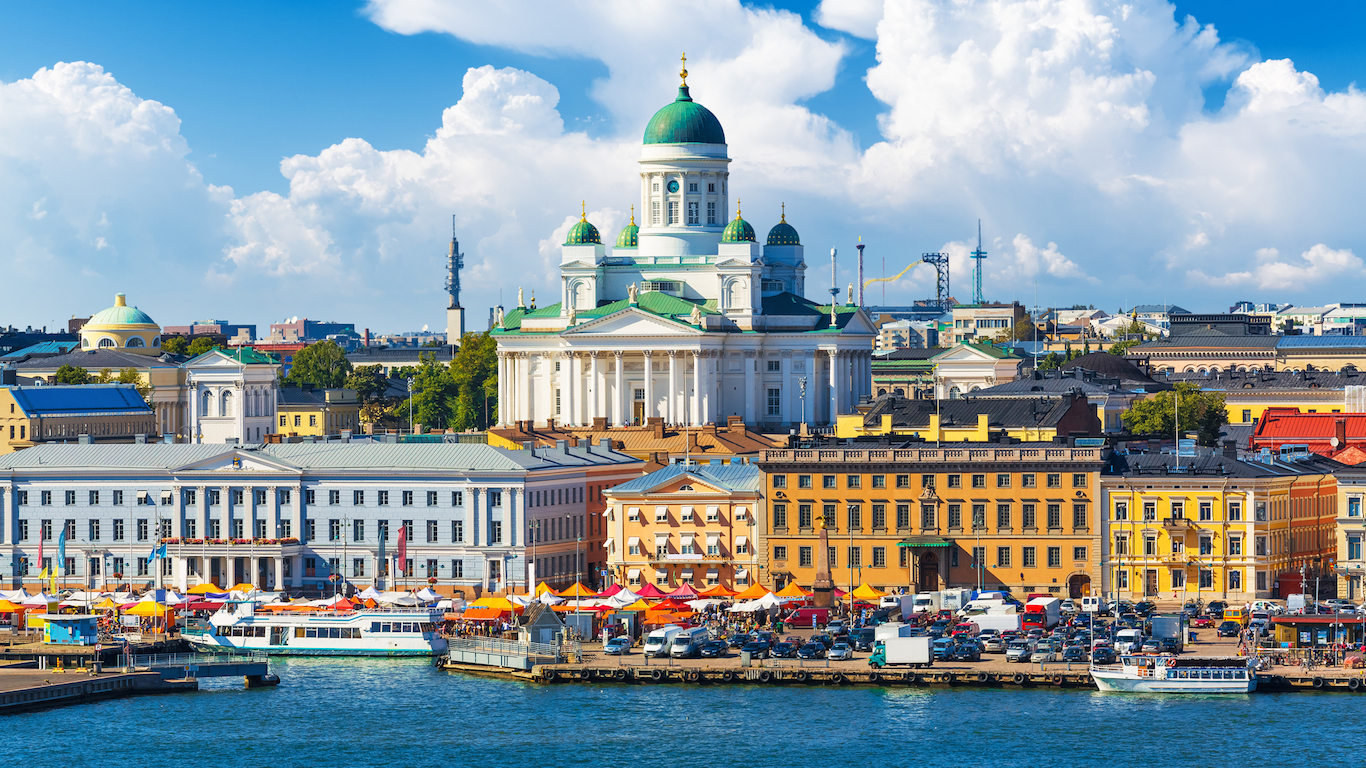
10. Finland
> 2015 GDP: $229.7 billion
> Life expectancy: 81.1 years
> Gov’t debt as % of GDP: 62.4%
> Patent applications (per million residents): 291.2
Like many other countries in Europe, Finland’s economy was closely tied to that of the Soviet Union during the Cold War, and suffered after markets collapsed in the early 1990s. Now a European Union member state, Finland has one of the most competitive economies in the world.
[in-text-ad]
Ranked slightly higher a year ago, the flagging global economy has undermined Finland’s competitiveness. Reduced demand from Russia, which is the third largest market for Finnish exports, is largely to blame for the country’s drop in ranking, according to the WEF. Still, Finland is an advanced innovation-driven economy, and is ranked as the best in the world for its legal institutions, and for health and primary education.

9. Hong Kong SAR
> 2015 GDP: $309.9 billion
> Life expectancy: 84.0 years
> Gov’t debt as % of GDP: 0.1%
> Patent applications (per million residents): N/A
Though technically a part of China, Hong Kong governs its own economy. The differences between the two economies are considerable, as Hong Kong’s economy is among the most competitive in the world, while China’s trails more than two dozen other countries.
With exceptional transportation infrastructure and effective and efficient government institutions, Hong Kong has a solid economic foundation. It is also one of the most efficient economies for business in the world, second to none in the affordability and efficacy of financial services. Hong Kong is lagging slightly in innovative capacity. However, the city-state’s trade and investment policies are some of the most open in the world, which according to the WEF, will lead to increasing competition and ultimately innovation in coming years.
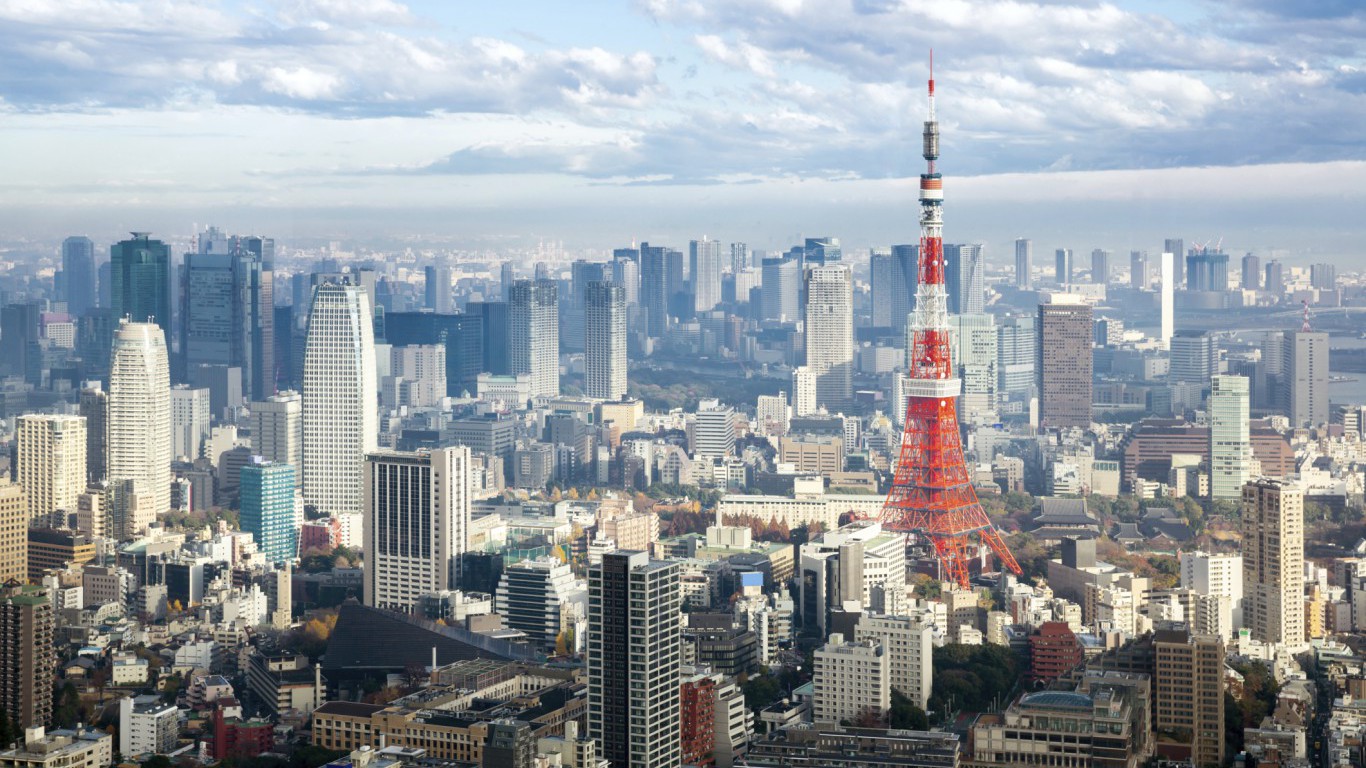
8. Japan
> 2015 GDP: $4.1 trillion
> Life expectancy: 83.6 years
> Gov’t debt as % of GDP: 248.1%
> Patent applications (per million residents): 335.4
The modern Japanese economy took shape in the decades after World War II, when booming automobile and consumer electronics industries helped establish the country as a major economic power. Today, with a GDP of $4.12 trillion, Japan is the third largest economy in the world.
The largest drivers of economic competitiveness in the Japanese economy are its sophisticated businesses, large market, high quality infrastructure, and its health and primary education institutions. The life expectancy in Japan of 83.6 years is the second highest in the world, and all eligible residents are enrolled in primary school. In terms of infrastructure, Japan has some of the highest quality roads and railroads on the globe, as well as 3.71 billion airline seat miles available per week, the fourth highest airline passenger carrying capacity in the world. Japan is also a highly innovative nation with the most patent applications per capita of any country.
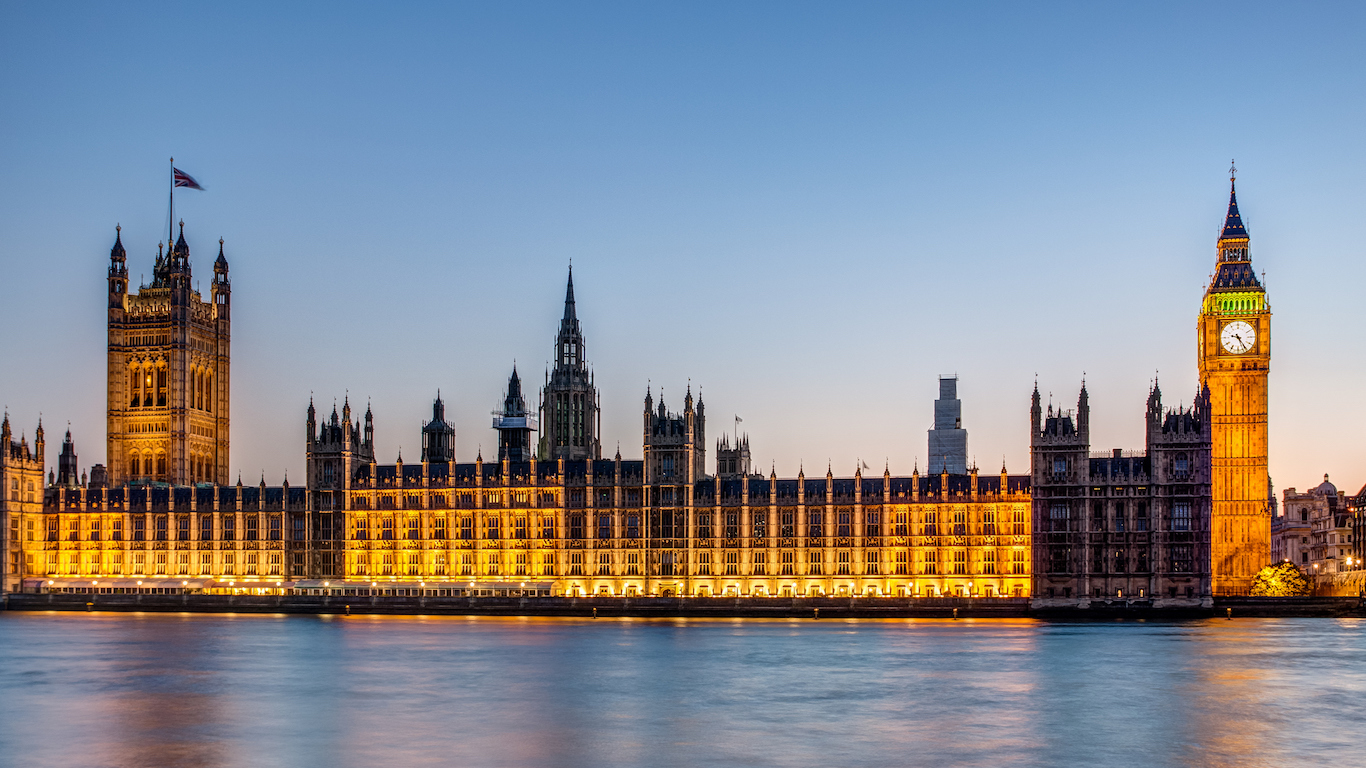
7. United Kingdom
> 2015 GDP: $2.9 trillion
> Life expectancy: 81.1 years
> Gov’t debt as % of GDP: 89.3%
> Patent applications (per million residents): 94.5
The United Kingdom economy ranks high in labor market efficiency and technological readiness. More than 90% of UK citizens use the Internet, which is among the fastest Internet on the planet. The country also ranks highly for its capacity to both attract and retain talented workers, and for its flexible hiring and firing practices. With a GDP of $43,771 per capita, the UK is also one of the wealthiest countries worldwide.
The effects the recent Brexit vote will have on the seventh most competitive economy are still unknown. Some of the UK’s most salient competitive features — the prevalence of foreign ownership and ability to attract international students and workers — may be negatively impacted by the country’s exit from the European Union.
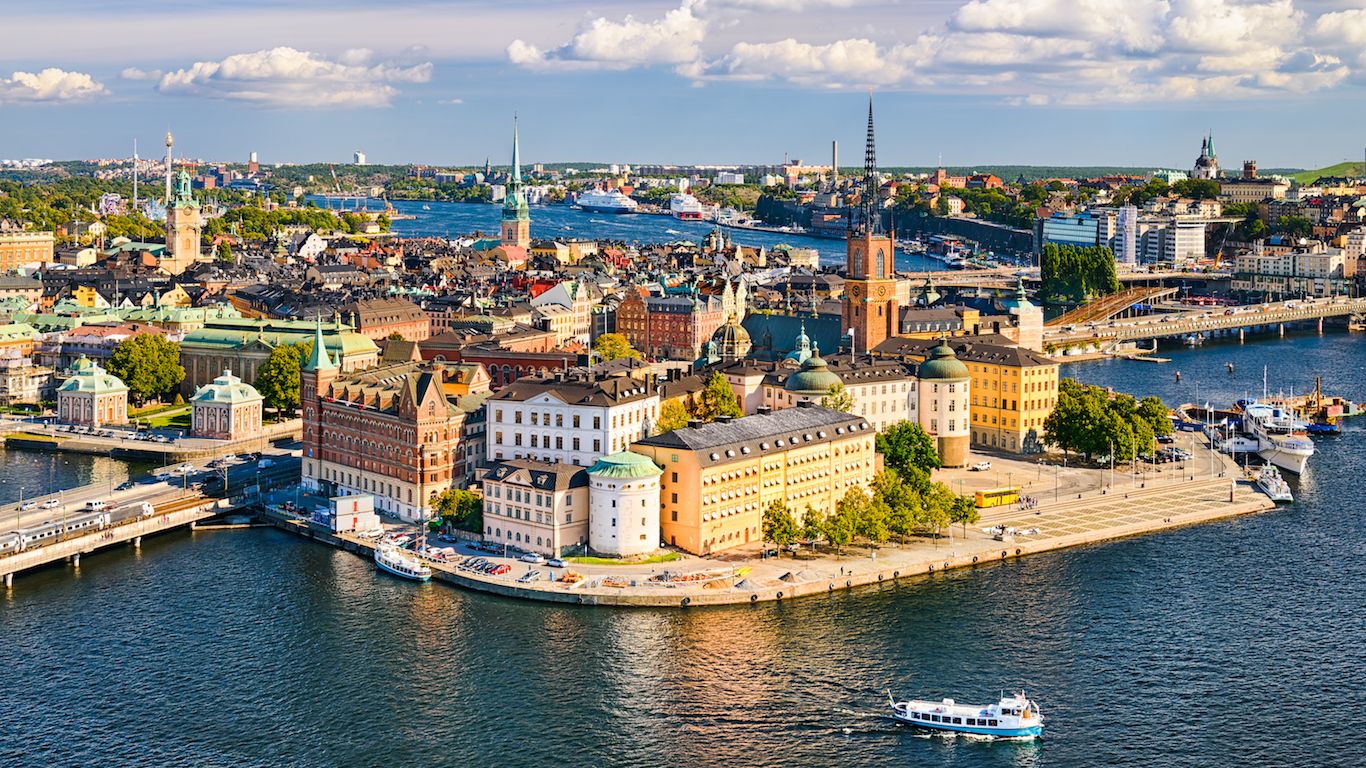
6. Sweden
> 2015 GDP: $492.6 billion
> Life expectancy: 82.0 years
> Gov’t debt as % of GDP: 44.1%
> Patent applications (per million residents): 320.0
Sweden’s economy is the most competitive of all Nordic countries and the sixth most competitive in the world. While the country’s high tax rates are considered a major impediment to economic competitiveness, those tax dollars fund some of the world’s most effective and efficient government institutions. The country ranks among the top 10 globally in property rights, public trust in politicians, judicial independence, and government spending.
Sweden is especially notable for its innovative capacity. Swedish companies spend far more than is typical on research and development, and the country’s universities are often heavily involved in R&D projects. Likely due to this emphasis on innovation, 320 patent applications are filed in the country for every 1 million residents, the second most of any country reviewed.
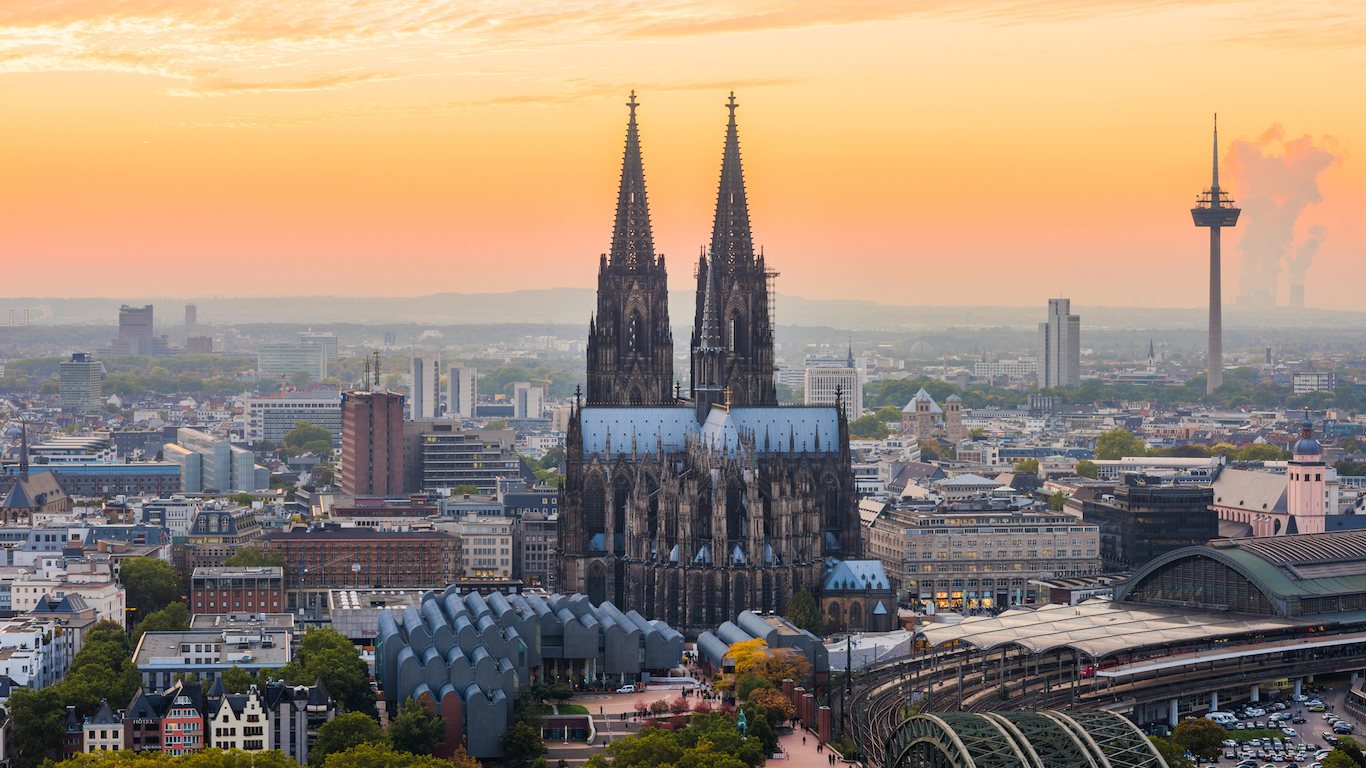
5. Germany
> 2015 GDP: $3.4 trillion
> Life expectancy: 80.8 years
> Gov’t debt as % of GDP: 71.0%
> Patent applications (per million residents): 219.1
Germany ranks fifth highest in competitiveness mostly due to its business practices and capacity for innovation. The country ranks among the world’s 10 best in all but one measure of business sophistication, including distribution control, production process sophistication, and local supplier quality. German companies are also some of the biggest spenders on R&D, and frequently collaborate with German universities.
[in-text-ad]
The country ranks 10th in the world for its relatively direct relationship between employee pay and productivity. However, with the arrival of over a million refugees in 2015 alone, the German labor market will likely face considerable challenges in the near future. The long-term economic implications of the sudden population influx remain to be seen.
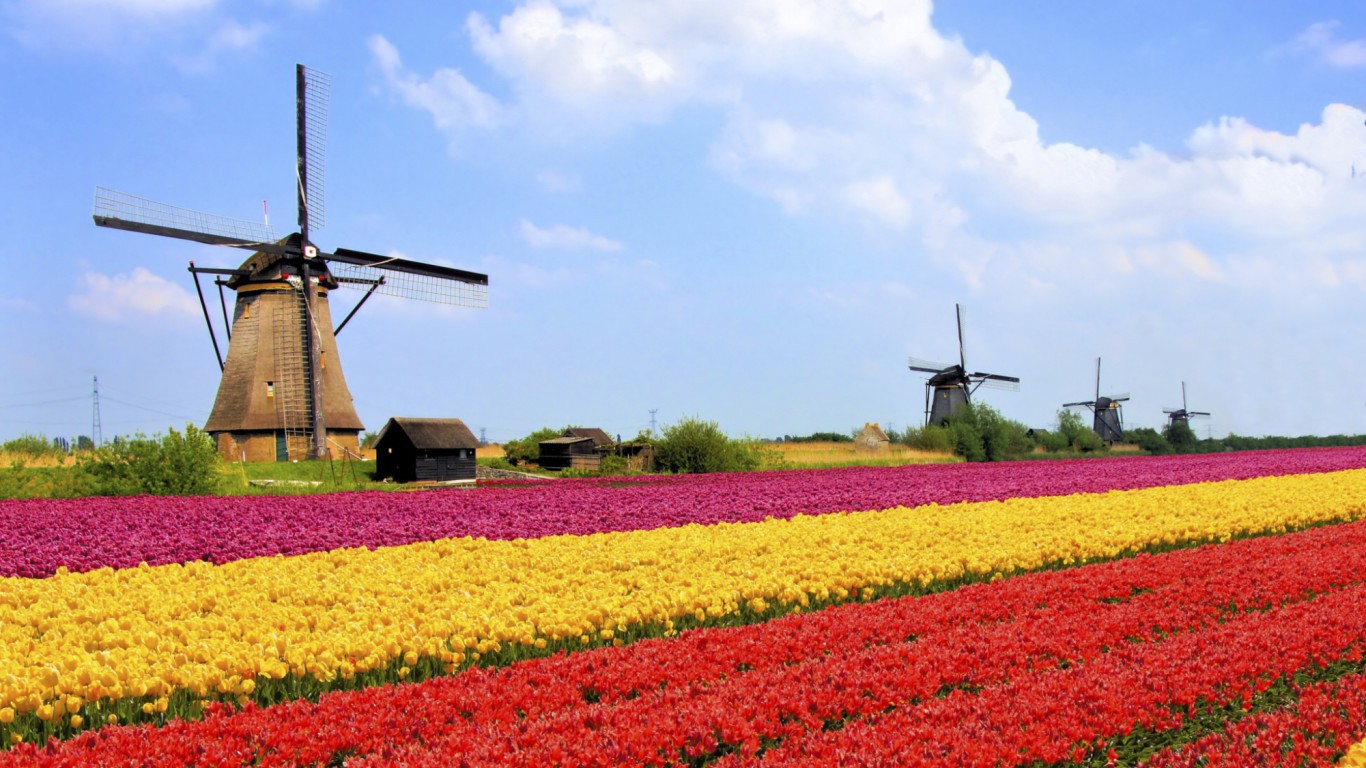
4. Netherlands
> 2015 GDP: $738.4 billion
> Life expectancy: 81.3 years
> Gov’t debt as % of GDP: 67.6%
> Patent applications (per million residents): 208.7
Situated between Belgium and Germany with considerable shoreline along the North Sea, Netherlands’ geographic location is ideal for international trade. With large advanced economies as neighbors and some of the world’s best transportation infrastructure — including ports that are second to none — the country’s 2014 exports of $525 billion were seventh highest in the world.
The country is also doing more than most to ensure younger generations are equipped for the future’s job market. The 99.6% primary school enrollment rate is the sixth highest in the world. The country is also notable for the quality of its higher education institutions. Math, science, and management schools in the Netherlands are each among the 10 best in the world.
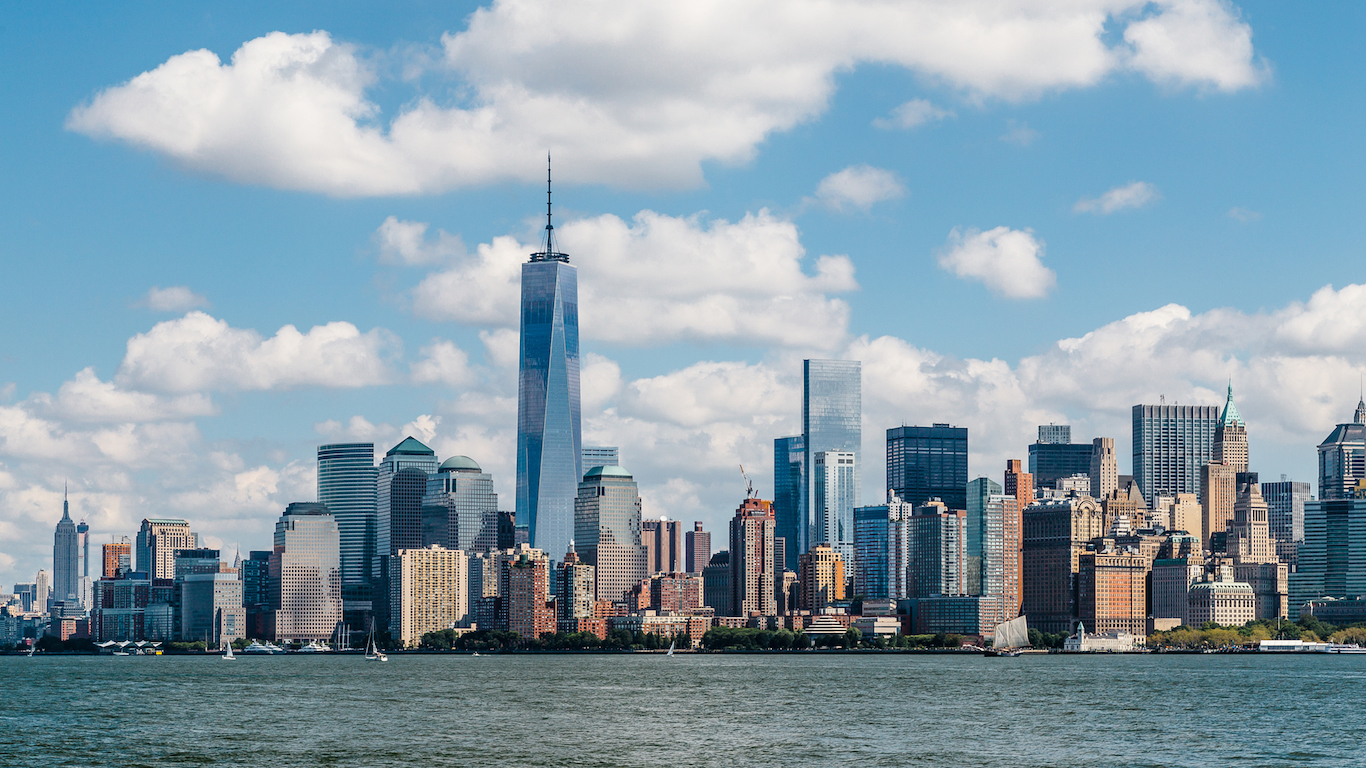
3. United States
> 2015 GDP: $17.9 trillion
> Life expectancy: 78.9 years
> Gov’t debt as % of GDP: 105.8%
> Patent applications (per million residents): 174.9
The U.S. economy is the largest in the world and the most competitive in North America. The United States’ R&D spending, capacity for innovation, and ability to retain talent, rank second in the world after only Switzerland.
Despite ranking third in the world for competitiveness, the U.S. economy has significant room for improvement in several areas. The United States does not rank among the 10 best countries in a variety of measures — health and primary education, property rights, and the public’s trust in politicians, for example, are each rated far worse than other countries on this list. Most glaringly, the country falls behind 73 other nations for wasteful government spending, and almost equally poorly in the toll crime and violence take on business.

2. Singapore
> 2015 GDP: $292.7 billion
> Life expectancy: 82.6 years
> Gov’t debt as % of GDP: 98.2%
> Patent applications (per million residents): 139.5
A small island nation in Southeast Asia, Singapore’s economy, while smaller than many, is the second most competitive in the world. The country’s economic strength comes from its effective government and legal institutions. The country ranks highest in public trust in politicians, government transparency, and efficiency in legal framework.
Singapore also excels in education and health standards, both important factors in economic prosperity. The country outranks all others in Internet access in schools and quality of math and science education, and it has a 100% primary school enrollment rate. Furthermore, at 82.6 years, Singapore has the sixth longest life expectancy at birth in the world.

1. Switzerland
> 2015 GDP: $664.6 billion
> Life expectancy: 82.8 years
> Gov’t debt as % of GDP: 45.6%
> Patent applications (per million residents): 313.5
For the eighth consecutive year, Switzerland ranks as the most competitive economy in the world. Reliable infrastructure and utilities are crucial to a thriving economy, and the quality of Switzerland’s overall infrastructure and electricity supply are the best in the world. While the country does especially well across nearly all measures considered, it is particularly outstanding for innovation. Swiss companies spend more on R&D than any other country, and Swiss research institutions, which are the best in the world, work closely with industry on R&D. Perhaps as a result, an average of 314 patents applications are filed per 1 million Swiss citizens, the third most worldwide.
The Swiss labor market is also the most efficient in the world. The country’s labor market has a more direct relationship between pay and productivity than any other country, and Switzerland’s ability to attract and retain talent is unmatched. With a GDP of $80,675 per capita, Switzerland is also one of the wealthiest countries on the planet.
The Least Competitive Economies
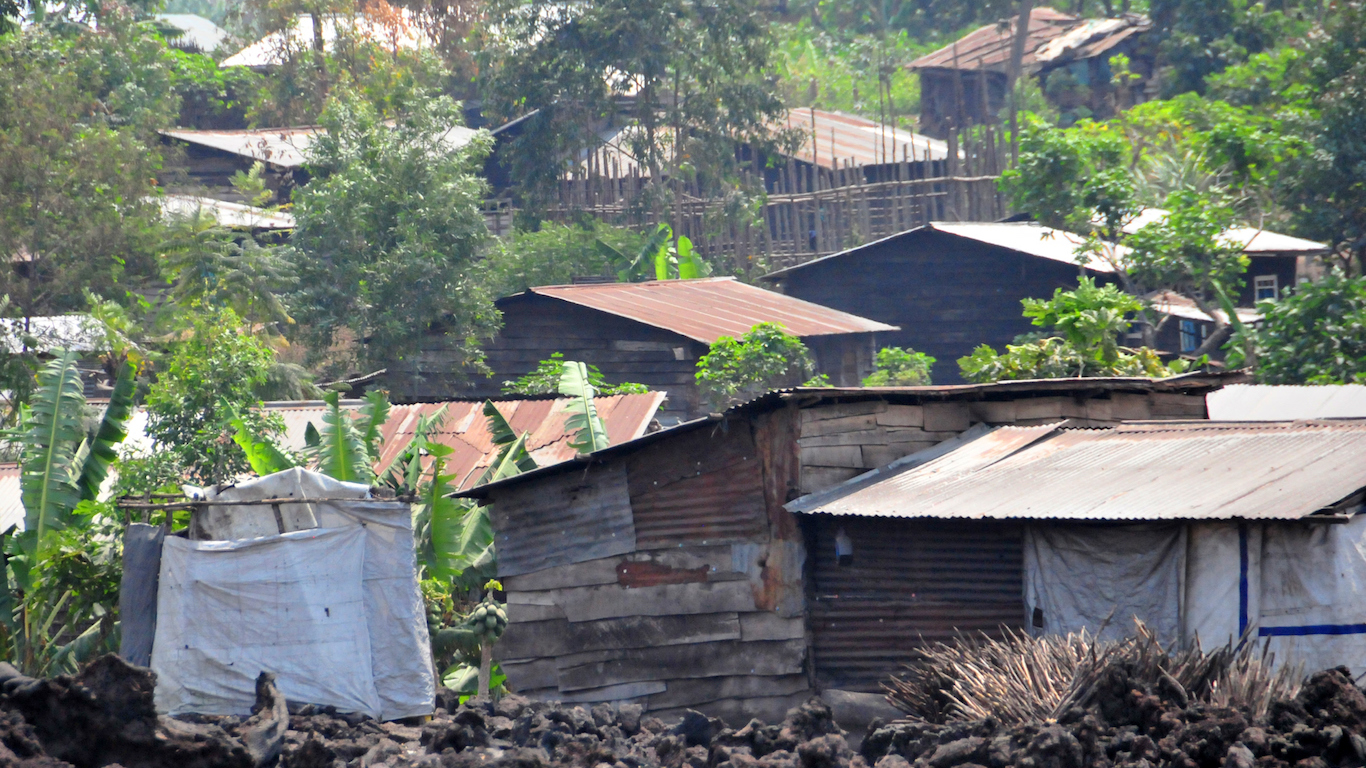
10. Congo, Democratic Rep.
> 2015 GDP: $38.9 billion
> Life expectancy: 58.7 years
> Gov’t debt as % of GDP: 18.8%
> Patent applications (per million residents): 0
The economic potential of resource rich Democratic Republic of the Congo has been stymied by conflict. The country emerged from a more than decade-long civil war in 2005. The war claimed hundreds of thousands of lives, and recent reports of political violence in the eastern part of the country threaten to start yet another civil war.
[in-text-ad]
Poor and lacking infrastructure are also among the most pressing challenges to the country’s economic development. There are effectively no fixed telephone lines, and the quality of roads and electricity supply are each nearly the worst of all countries surveyed. The WEF cites corruption as another primary hindrance to economic competitiveness.
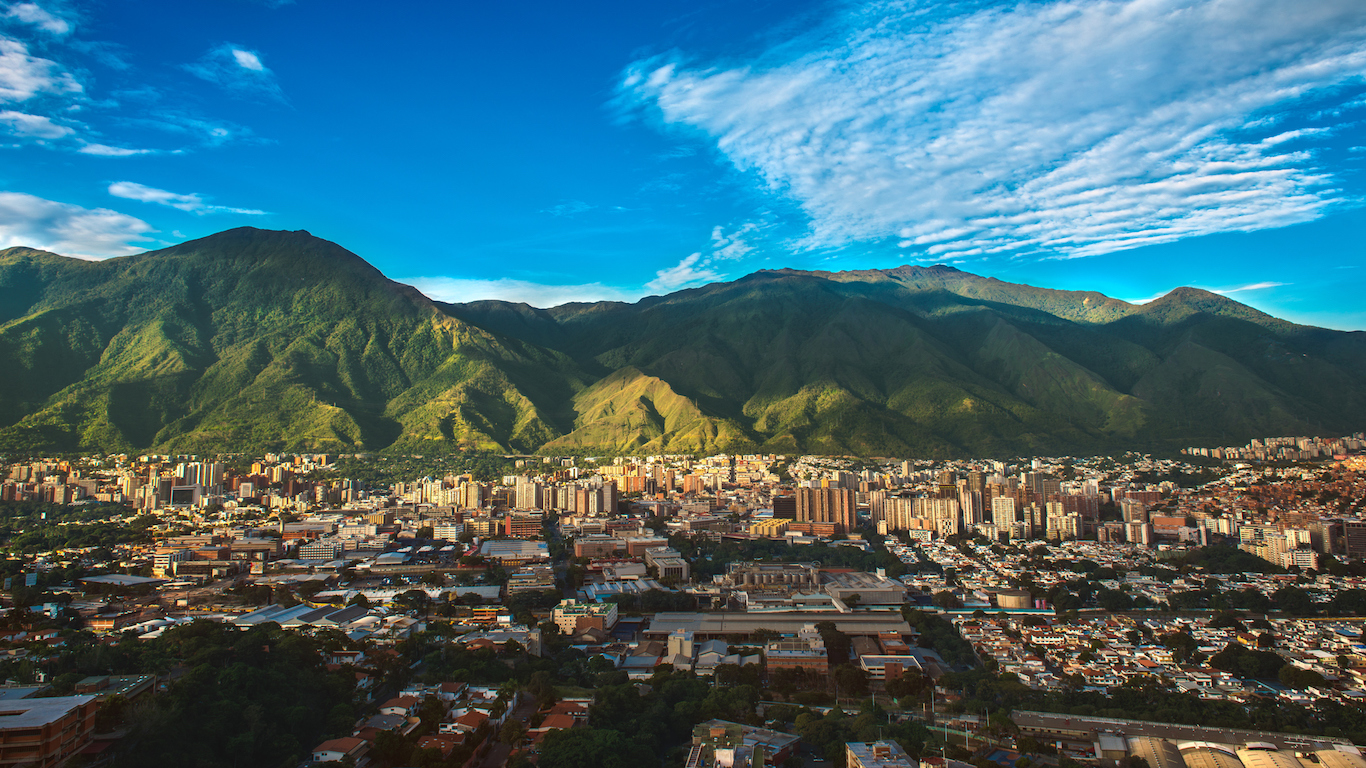
9. Venezuela
> 2015 GDP: $239.6 billion
> Life expectancy: 74.2 years
> Gov’t debt as % of GDP: 48.8%
> Patent applications (per million residents): 0.3
Venezuela has some of the largest proven oil deposits in the world. Like many oil-rich states, the country’s economy is heavily dependent on global oil markets. With oil prices beginning to decline in 2013 and dropping significantly in 2014, Venezuela’s economy suffered considerable negative consequences. Oil production in the country hit a 13-year low in July 2016.
One of the most pressing issue the country faces, however, is inflation. The cost of goods and services shot up 121.7% in 2015, the second highest inflation rate of all 138 countries reviewed. Not only is inflation expected to continue, but it will likely accelerate. The International Monetary Fund projects inflation will hit 480% this year and exceed 1,640% by 2017.
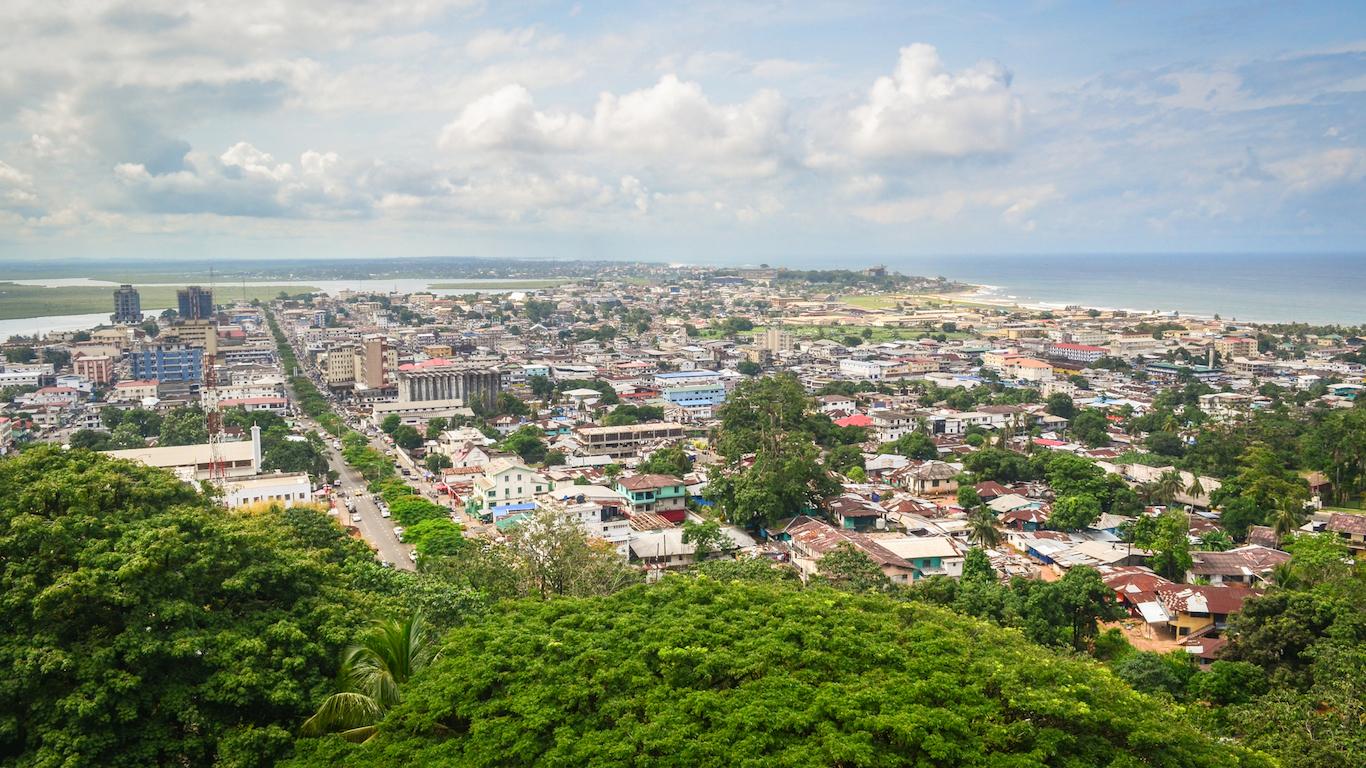
8. Liberia
> 2015 GDP: $2.0 billion
> Life expectancy: 60.8 years
> Gov’t debt as % of GDP: 40.0%
> Patent applications (per million residents): 0
Ravaged by years of civil war in the 1990s and more recently one of the deadliest Ebola outbreaks in history, Liberia is far from achieving economic stability. Among the largest obstacles to doing business in Liberia are limited access to financing, government instability, corruption, and crime and theft.
Liberia’s health and primary education systems are also rated very poorly. There are an estimated 308 cases of tuberculosis for every 100,000 Liberians each year, nearly the highest incidence of tuberculosis of any country. Additionally, just 37.9% of eligible Liberians are enrolled in secondary education, one of the smallest shares in the world. Health epidemics and the lack of access to education is likely to continue to limit business activity in the country. Liberia’s GDP per capita of just $474 is lower than almost any other nation.
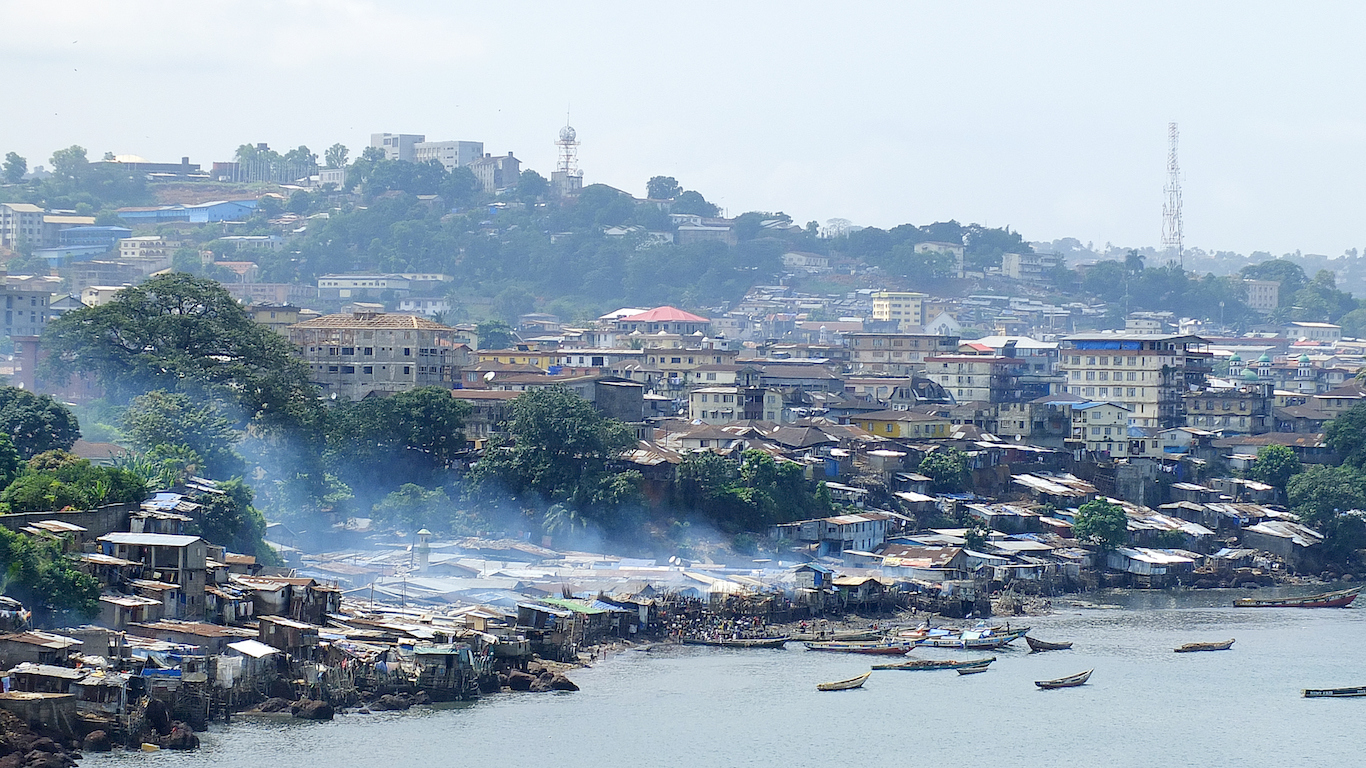
7. Sierra Leone
> 2015 GDP: $4.2 billion
> Life expectancy: 50.9 years
> Gov’t debt as % of GDP: 46.1%
> Patent applications (per million residents): 0.1
Sierra Leone’s vast mineral resources include gold, bauxite, and iron. The country is most notable for its diamond deposits — diamonds accounted for more than 8% of its total exports in 2014. However, the country’s mineral resources have often proven to be more of a curse than a gift, as diamonds have historically funded devastating conflicts in the country.
Today, corruption is a primary hurdle to Sierra Leone’s economic development. An official audit revealed that just a third of the state’s funding to fight Ebola, is unaccounted for. In addition, though the country has improved in infrastructure and health care in the last year, glaring deficiencies remain. Of all countries reviewed, Sierra Leone has the highest infant mortality rate and the second lowest life expectancy at only 50.9 years. The country also has poor quality roads and lacks reliable electricity.

6. Mozambique
> 2015 GDP: $15.0 billion
> Life expectancy: 55.0 years
> Gov’t debt as % of GDP: 74.8%
> Patent applications (per million residents): 0
Like many countries with the least competitive economies, Mozambique’s economic development has been hindered by conflict. Not long after the country gained independence from Portugal in 1975, it plunged into civil war. Though the war officially ended in 1992, the effects remain, and recent violence suggests the country may again erupt in conflict.
Many other factors, in addition to the civil war’s legacy, are impeding the Mozambique economy. The country’s institutions, both private and public, are greatly lacking. For example, police services are among the least reliable of any of the 138 countries examined, and illegal diversion of public funds is relatively common. The youngest generation is also not likely to be adequately trained to fix the country’s many problems. At 24.5%, secondary education enrollment is the second lowest of all countries reviewed.
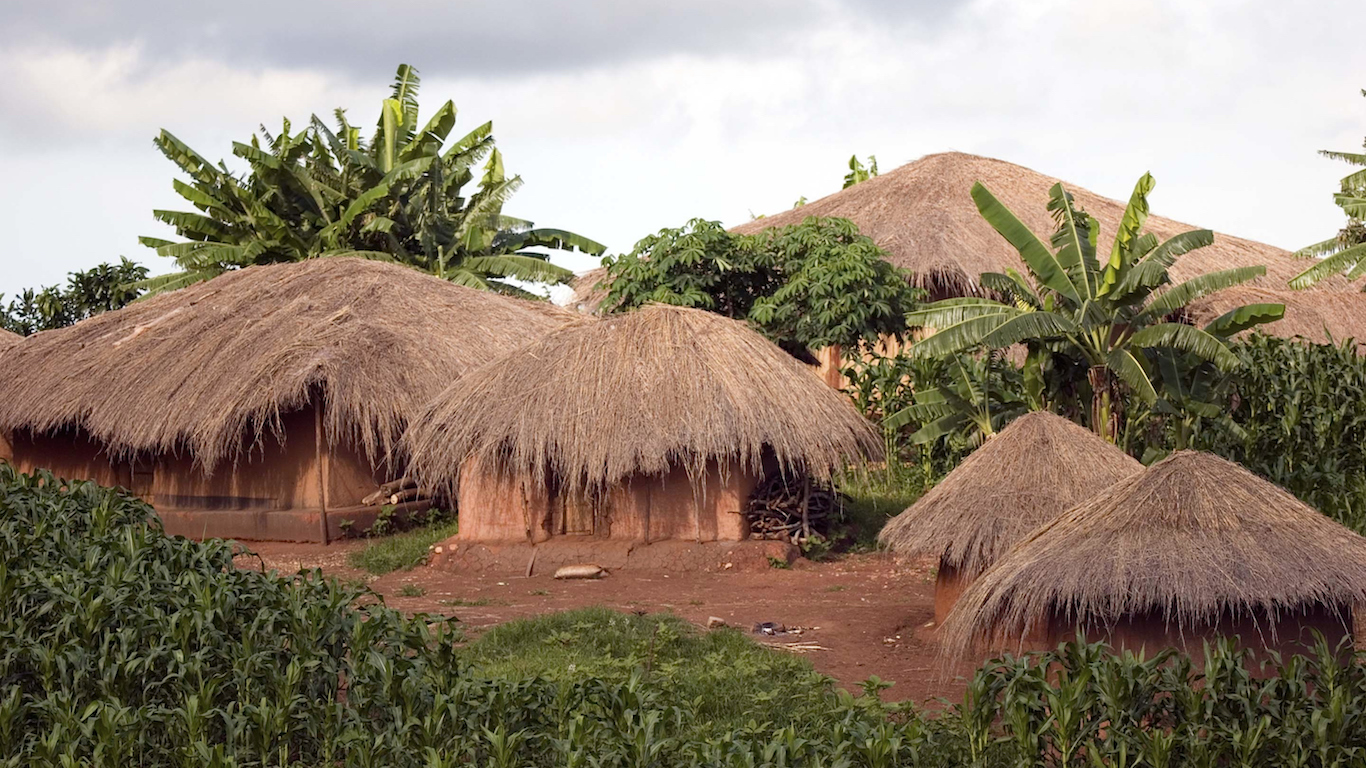
5. Malawi
> 2015 GDP: $6.4 billion
> Life expectancy: 62.7 years
> Gov’t debt as % of GDP: 83.4%
> Patent applications (per million residents): 0
Malawi’s battle with governmental corruption and HIV has long hindered economic development. An estimated one in 10 Malawi residents is infected with HIV, a higher proportion than nearly anywhere else on the planet. Similarly, there are 227 cases of tuberculosis for every 100,000 Malawians, one of the highest incidences of the disease of any country.
[in-text-ad]
Additional obstacles to doing business in Malawi are the minimal access to financing, high inflation, and inadequate infrastructure. Malawi has some of the lowest quality roads, ports, and air transport infrastructure in the world, and about two in every three citizens lack a mobile phone subscription. Despite economic growth in recent years, Malawi is still one of the world’s poorest countries. Malawi’s GDP per capita of just $354 is less than 150th that of the United States.
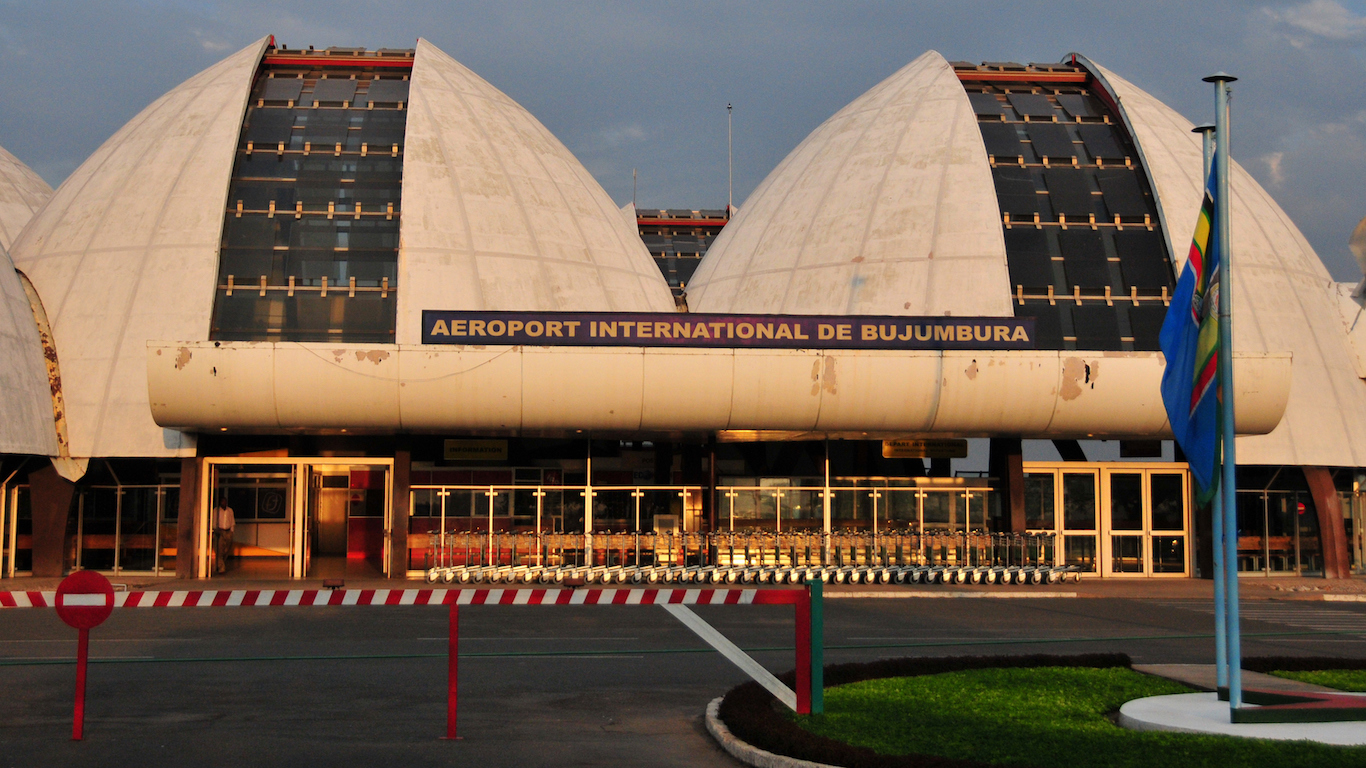
4. Burundi
> 2015 GDP: $2.9 billion
> Life expectancy: 56.7 years
> Gov’t debt as % of GDP: 38.4%
> Patent applications (per million residents): 0
A landlocked country in central Africa, Burundi suffered through a bloody civil war between Tutsi and Hutu ethnic groups. Now, more than a decade after the end of the war, the country struggles with political violence. In addition to violence and political instability, Burundi faces serious corruption problems. The country’s president crippled press freedom in 2013 by making it illegal to report on matters that could be deemed to undermine the national economy or public order. Perhaps not surprisingly, the country ranks among the worst in transparency of government policymaking. It is also among world’s most egregious offenders of illegal diversion of public funds.
Diseases such as AIDS and tuberculosis are also considerable obstacles to business in Burundi. Due in part to the effects of these diseases, life expectancy in the country is only 56.7 years.

3. Chad
> 2015 GDP: $10.9 billion
> Life expectancy: 51.6 years
> Gov’t debt as % of GDP: 39.3%
> Patent applications (per million residents): 0
The business environment in Chad, Africa’s fifth largest country, is rife with problems. The relationship between pay and productivity in the country’s workforce is the third worse of all 138 countries examined, and businesses in the country are some of the least likely to be able attain the financial services they need.
Chad is also the least technological country of all those examined. The country ranks last in the availability of the latest technologies, and only 2.7% of its population are Internet users. With extremely limited technological capabilities, the country is severely handicapped in terms of business sophistication and capacity for innovation.
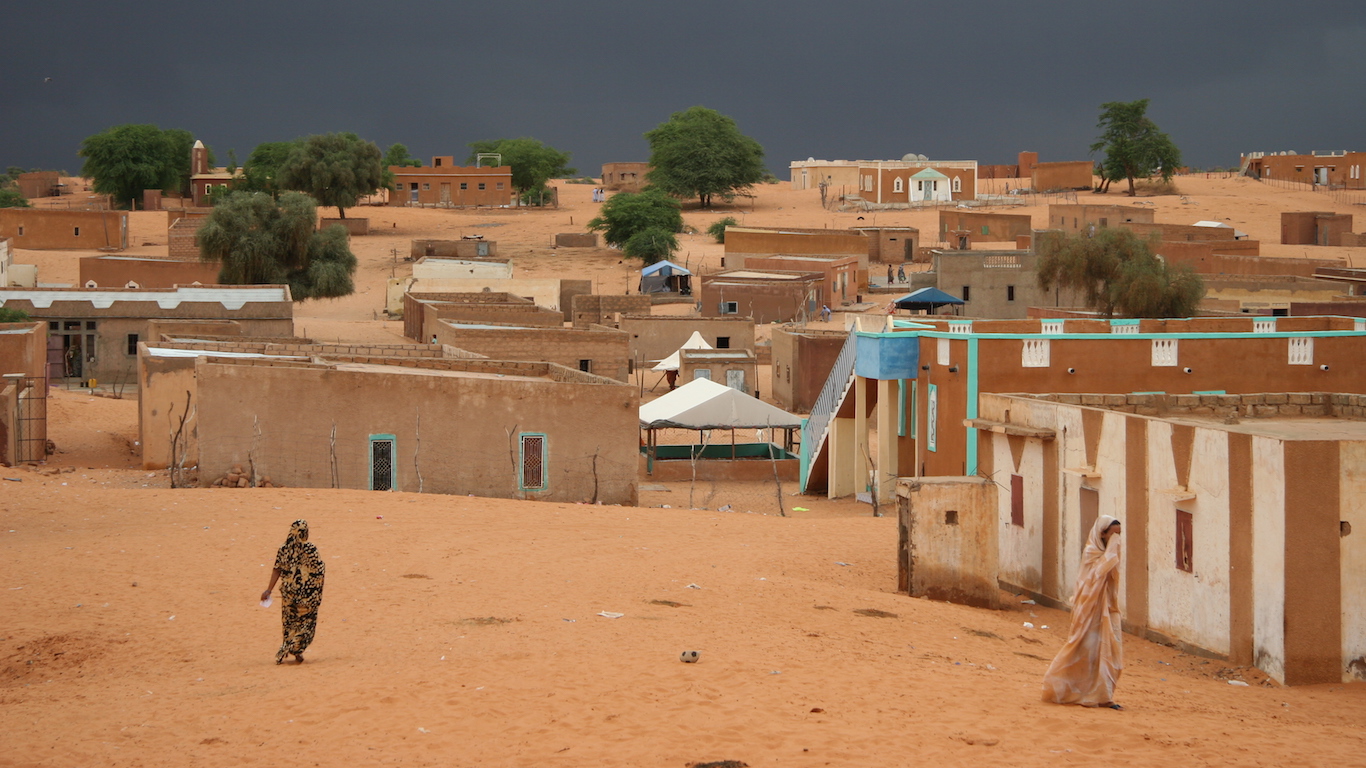
2. Mauritania
> 2015 GDP: $4.8 billion
> Life expectancy: 63.0 years
> Gov’t debt as % of GDP: 78.1%
> Patent applications (per million residents): 0
Mauritania has the lowest quality of overall infrastructure of all 138 countries examined. The quality of the country’s roads and air transport infrastructure — a basic requirement for conducting business — is particularly poor. The country’s business and government institutions are also anything but reliable. The country ranks last in ethical behavior of firms, efficacy of corporate boards, and irregular payments and bribes. It ranks second to last in police service reliability and auditing and reporting standards.
Poor infrastructure and low confidence in public and private institutions does little to foster innovation in Mauritania. With the lowest private sector R&D spending of any country examined, Mauritania ranks last in its capacity for innovation.

1. Yemen
> 2015 GDP: $36.9 billion
> Life expectancy: 63.8 years
> Gov’t debt as % of GDP: 68.6%
> Patent applications (per million residents): 0
Formed in 1990, when South Yemen and North Yemen merged, Yemen is less than 30 years old. The country, which today is in the midst of a civil war, has the least competitive economy of all 138 countries examined. Located on the southern end of the Arabian Peninsula, terrorism has taken a greater toll on business in Yemen than in any other country. Both Al-Qaeda and the Islamic State have bases within the country.
The country’s productivity is also undermined by poor infrastructure. In addition to poor quality roads and airports, Yemen has the lowest quality electricity supply of any country examined. Conditions in the country are not likely to improve as younger generations take over. Yemen’s primary school quality and enrollment rate trail nearly every other country examined.
Thank you for reading! Have some feedback for us?
Contact the 24/7 Wall St. editorial team.